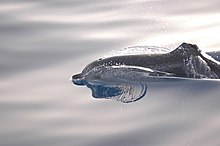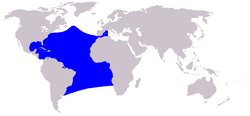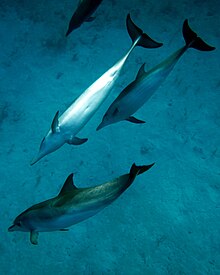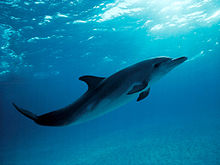Taxonomy
The Atlantic spotted dolphin was first described by Cuvier in 1828. Considerable variation in the physical form of individuals occurs in the species, and specialists have long been uncertain as to the correct taxonomic classification. Currently, just one species is recognised, but a large, particularly spotty variant commonly found near Florida quite possibly may be classified as a formal subspecies or indeed a species in its own right.Atlantic spotted dolphins in the Bahamas have been observed mating with bottlenose dolphins.[3] Rich LeDuc has published data that suggest the Atlantic spotted dolphin may be more closely related to bottlenose dolphin (genus Tursiops) than to other members of the genus Stenella.[3]
Description

The Atlantic spotted dolphin has a three-part coloration: dark gray back, lighter sides, and a white belly.
Measurements at birth:
- Length: about 35–43 in (89–109 cm)
- Weight:
- Length:
- Male 2.26 m (7 ft 5 in)
- Female 2.29 m (7 ft 6 in)
- Weight: 310
- Male 140 kg (310 lb)
- Female 130 kg (290 lb)
In common with other species in its genus, the Atlantic spotted dolphin is a gregarious creature. It is a fast swimmer and keen bow-rider, and prone to acrobatic aerial displays.
Population and distribution

The species is endemic to the temperate and tropical areas of the Atlantic Ocean. It has been widely observed in the western end of the Gulf Stream, between Florida and Bermuda. Off the Bahamas, tourism industries to swim with dolphins are available.[4] It is also present in the Gulf of Mexico. More infrequent sightings have been made further east, off the Azores and Canary Islands. Northerly sightings have been made as far north as Cape Cod across to the southwestern tip of Spain. They are certainly present further south, too, as far as Rio Grande do Sul in Brazil and across to west Africa, but their distribution is poorly understood in these areas.
About 20 years ago, only about 80 dolphins were in the Bahamas. Now, almost 200 dolphins are found there. On account of their similar appearance to other dolphins in their range, it is difficult to be sure of the Atlantic spotted dolphin's population. A conservative estimate is around 100,000 individuals.
Human interaction
Some Atlantic spotted dolphins, particularly some of those are around the Bahamas, have become habituated to human contact. In these areas, cruises to watch and even swim with the dolphins are common.Atlantic spotted dolphins are an occasional target of harpoon fishermen, and every year some creatures are trapped and killed in gill nets, but these activities are not currently believed to be threatening the survival of the species. This species lives in the mesopelagic layer of the ocean. These dolphins are not threatened by extinction, however, commercial trade may affect their evolution and sustainability. Sometimes they are killed by harpoons off St. Vincent.



No comments:
Post a Comment
Note: Only a member of this blog may post a comment.